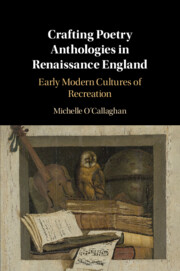Book contents
- Crafting Poetry Anthologies in Renaissance England
- Crafting Poetry Anthologies in Renaissance England
- Copyright page
- Contents
- Illustrations
- Acknowledgements
- Note on the text
- Introduction
- Chapter 1 Books in Process
- Chapter 2 Household Books
- Chapter 3 ‘To the Gentleman Reader’
- Chapter 4 ‘Impos’d designe’
- Chapter 5 A Poetical Rapsody
- Conclusion
- Bibliography
- Index
Chapter 3 - ‘To the Gentleman Reader’
Re-creating Sidney in the 1590s
Published online by Cambridge University Press: 23 December 2020
- Crafting Poetry Anthologies in Renaissance England
- Crafting Poetry Anthologies in Renaissance England
- Copyright page
- Contents
- Illustrations
- Acknowledgements
- Note on the text
- Introduction
- Chapter 1 Books in Process
- Chapter 2 Household Books
- Chapter 3 ‘To the Gentleman Reader’
- Chapter 4 ‘Impos’d designe’
- Chapter 5 A Poetical Rapsody
- Conclusion
- Bibliography
- Index
Summary
The 1580s were comparatively lean years for the publication of new multi-authored poetry anthologies, even though book buyers were well supplied by further, often revised editions of those collections first compiled in the preceding decades. The 1590s saw the production of new titles: Brittons Bowre of Delights (1591, 1597), The Phoenix Nest (1593), Arbor of Amorous Devices (c. 1593, 1597), and The Passionate Pilgrime (1599). The event that stimulated new production and commanded the attention of so many writers and publishers was the posthumous publication of the works of Sir Philip Sidney: his Countess of Pembroke’s Arcadia in 1590, Astrophil and Stella in 1591, and An Apology for Poetry in 1595. Not since Surrey and Wyatt had there been a poet who combined the prestige of court service with humanist dedication to literary experimentation across the major genres. Early funeral elegies mourning his death commemorate Sidney primarily as a Protestant knight, a pattern of chivalry and courtliness, making only brief reference to his writings, if at all, even though many of his works, especially his songs, had been circulating in manuscript throughout the 1580s. What transformed Sidney’s reputation is print. In Gavin Alexander’s words, Sidney’s ‘life as a published author was posthumous’. The sheer range of his works, from pastoral romance, songs and sonnets, and religious poetry to translations and a treatise on poetry, transformed the field of literary production. The Sidney remembered in the 1590s was now newly embodied through his literary corpus. Elegies for Sidney frame Brittons Bowre and The Phoenix Nest, turning the anthology into a space for determining Sidney’s literary legacy and its implications for vernacular poetry. The Sidney who emerges from this process, however, is less uniform than is often assumed. Instead, variant versions of Sidney were put into circulation that then become the basis for alternative histories of vernacular poetry.
- Type
- Chapter
- Information
- Crafting Poetry Anthologies in Renaissance EnglandEarly Modern Cultures of Recreation, pp. 114 - 149Publisher: Cambridge University PressPrint publication year: 2020



